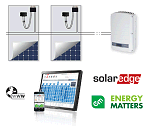I found the following:
In summary, Optimizers are less costly than Microinvertors but are not as scalable.
Also, I understand that MicroInvertors may not be as reliable and have more parts which increases the mean time between failure.
In summary, Optimizers are less costly than Microinvertors but are not as scalable.
Also, I understand that MicroInvertors may not be as reliable and have more parts which increases the mean time between failure.


Comment